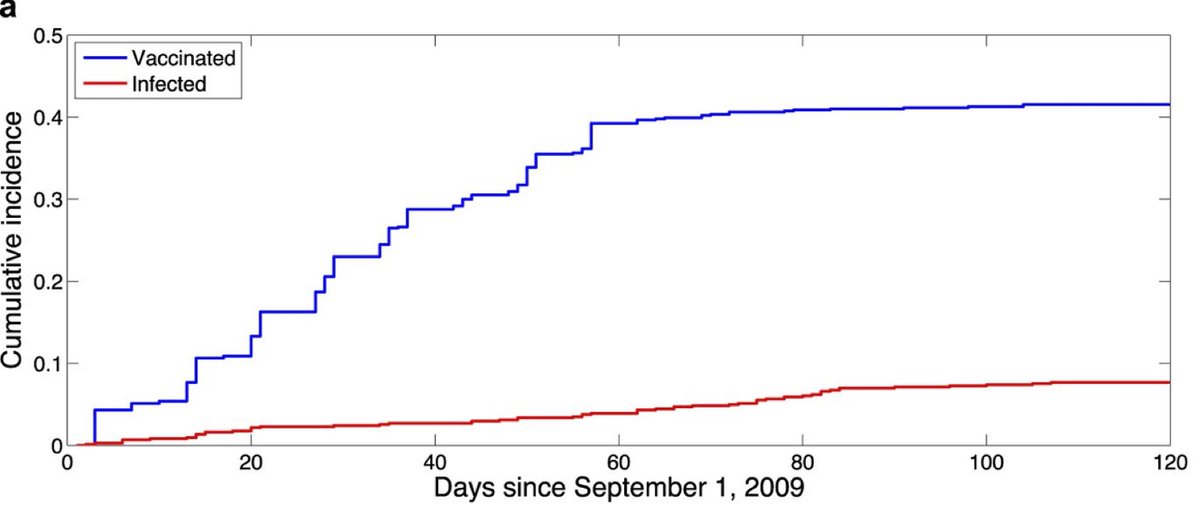
We are racing to vaccinate the US and worldwide population for COVID19 for many reasons: to prevent deaths, limit emergence of dangerous strains, and achieve herd immunity. Let’s talk about the spread of vaccination behavior. 1/
We can think of some of our behavioral responses to an epidemic like #COVID19 (e.g., mask wearing, getting vaccinated) as a kind of *social contagion*, spreading from person to person, which in turn addresses the *biological contagion*. 2/
In 2017, we published a reconstruction of the temporal dynamics of the spread of vaccination behavior and of the H1N1 influenza virus during the 2009 pandemic in a circumscribed social network of @harvard students. nature.com/articles/srep4… via @SciReports @nature 3/
We could trace out how *both* the virus and vaccination behavior spread across social ties across time, day by day over four months, as the 2009 H1N1 epidemic peaked. 4/
Here is how the H1N1 virus spread over a period of three months in 2009. Infected individuals are colored red, friends of infected individuals are colored yellow, and node size is proportional to the number of friends infected. 5/ 

A video of the spread of the H1N1 virus from person to person in a defined social network during the 2009 pandemic is here: doi.org/10.1371/journa… via @PLOSONE 6/
People are more likely to get the flu if their friends get the flu. And people are also more likely to manifest behaviors (e.g., vaccination, masking) if their friends do so. 7/
Furthermore, each of those phenomena – the virus and behavior – affects the spread of the *other* phenomenon. 8/
We can think of these two contagions – one biological and one social – as a kind of *dueling contagion*. Each affects the other. This is the key idea behind #duelingcontagions. Which contagion wins out, and under what circumstances? 9/
Using data collected during the 2009 H1N1 pandemic that includes information about vaccination, flu, and the detailed structure of face-to-face social networks, we showed that well-connected individuals are more likely to get vaccinated. 10/
Using data collected during the 2009 H1N1 pandemic, we also showed that people who are exposed to friends who get vaccinated or are exposed to friends who get the flu are then more likely to get vaccinated. 11/
Our dueling contagion model suggests that the rate of vaccination contagion may be even *more* important than the biological contagion in determining the overall course of the epidemic. 12/
This figure shows the cumulative incidence of vaccinated individuals and of infected ones starting September 1, 2009 during the H1N1 pandemic. Levels of vaccination and of disease prevalence increase from zero and reach a plateau almost at the same time. 13/ 

This figure displays snapshots of the social network at time point t = 10, 40, 120 days. Size of nodes is proportional to network degree, and color of nodes represents their health status: RED infected, BLUE vaccinated, and GRAY are unvaccinated and healthy. 14/ 

The network snapshots provide a microscopic, spatio-temporal view of the dueling contagions on the friendship network, showing that the relatively fast spread of vaccination behavior impedes the spread of the germ and the development of a severe epidemic. NB @vivek_murthy 15/
Real world and online networks that make it easier to actually see when friends have been vaccinated (personalized vaccination campaigns) and when they get the flu (personalized flu warnings) could have a large impact on reducing the severity of epidemics. 16/
A similar formulation of the idea of #duelingcontagions was advanced by @Alison_Galvani and @cbauch1 in @ScienceMagazine in 2013: science.sciencemag.org/content/342/61… 17/
An old thread about the spread of the flu virus in this social network, along with other links and information, is here:
https://twitter.com/NAChristakis/status/1235566497591742464?s=20These ideas also find use in our HUNALA app useful for assessing personal risk of COVID19 @HunalaApp 18/
An old thread about practical issues in actually getting a large fraction of the population vaccinated (inventing, manufacturing, distributing, and administering the COVID19 vaccine) is here:
https://twitter.com/NAChristakis/status/130804089443677798419/
If you are interested in how social behavior changes in times of plague, and how this change in behavior affect the spread of pathogens more generally, there is more in #ApollosArrow: amazon.com/Apollos-Arrow-… 20/
• • •
Missing some Tweet in this thread? You can try to
force a refresh



